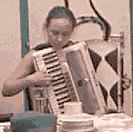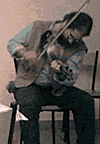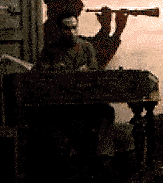 Evy says something that could be "one two three" in Hungarian (or English, for that matter) and the band is off. The clarinet is
very loud compared to the violin, bass, and accordion. Bob is holding the violin almost vertically as he moves the bow up and down across the strings.
Evy says something that could be "one two three" in Hungarian (or English, for that matter) and the band is off. The clarinet is
very loud compared to the violin, bass, and accordion. Bob is holding the violin almost vertically as he moves the bow up and down across the strings.
The accordion player,  Christina, langorously slides into the next tune. The bass joins in after a few bars. Then the violin adds some new riffs, until, finally, underneath it all, the clarinet, giving the music a silkier, city sound. When the clarinet drops out you can see in your minds eye the villagers dancing around and around, and easy twenty minutes a song, line dances and circles, men separate from women, everyone warming up until the fiddler gives the signal to kick up the tempo.
Christina, langorously slides into the next tune. The bass joins in after a few bars. Then the violin adds some new riffs, until, finally, underneath it all, the clarinet, giving the music a silkier, city sound. When the clarinet drops out you can see in your minds eye the villagers dancing around and around, and easy twenty minutes a song, line dances and circles, men separate from women, everyone warming up until the fiddler gives the signal to kick up the tempo.  Bob belts out the melody to "In Odessa" as the clarinet follows along for a few bars. When the band decides that folks are relaxed enough, they kick up the intensity another notch and break into another, faster melody.
Bob belts out the melody to "In Odessa" as the clarinet follows along for a few bars. When the band decides that folks are relaxed enough, they kick up the intensity another notch and break into another, faster melody.  Géza's beat and melody on the bass are impeccable, proving an old contention of mine that a drum is not necessary for most klez.
Géza's beat and melody on the bass are impeccable, proving an old contention of mine that a drum is not necessary for most klez.
The smoke gets more intense. Earlier I asked, "Is this going to be another smoke-filled bar?" "Oh, no!" replied Bob. Easy for him to say. Everyone in the band seems to chain smoke. My throat is crying, "take me home!" Next month, throat, just hold on.
This time, in between numbers, there is a lengthy explanation. Unfortunately, it is in Hungarian, which is fine for the audience, but leaves me rather in the dark. (I did get the explanations the next month, when I caught the band, still great, in Berlin;.)
After a weepy ballad ("I drink not, I eat not, I sleep not all night...."), the full band eventually swings into a new dance tune.
There are some interesting differences in the sounds I am hearing tonight than those I would hear from an American klezmer band. First off, there are no jazz or rock overtones. The clarinet sounds most American, but that may be an unfair note--Eve has been hired for the summer and is American. (Several members in the band do indicate later that she might be back next summer, too.) On this number I can hear a lot of Hungarian folk rhythms. The accordion and violin seem more pervasive and less aggressive than might be the case in an American band.
A song later I am starting to get it. There is a scraping to the fiddle that at first seems ... scraping, and then seems to pull the feet along, to drag the melody into an intensity totally at odds with the pace and piece. It is something special. It is like tasting paprika for the first time. I think that part of it is that these aren't songs in the American sense--a careful set of three or four verses with, perhaps, some individual solos somewhere around the bridge. This is music that continues, melody stitched to melody, slight changes of rhythm, and the band continues to play. You can see in your minds eye the people dancing and dancing and always dancing just a little faster, just a little happier, and Bob breaks into song, and the feet in my minds eye kick up their heels a little higher and move a little faster still. It isn't just me. My friend Pearl, sitting next to me and thinking similar thoughts, says, "If I ever get married, this is the band I want to have play at my wedding."
Each bit of melody is familiar, although I can usually not place any piece exactly. It is a new cloth made of familiar threads, an improvisation, the making of a Hungarian or Romanian Jewish musical quilt, in a way that is far less tidy, and far more intense, to my ears, than the twentieth century "pop" way of playing. (And, of course, after a day of listening to Josh, and then to his music, and then listening to Bob on the long bus ride here, I am well-primed to be thinking exactly of the differences between village playing and concert playing, between 19th century playing, and that of the modern American wedding. I can understand why the hassidim still love this way--although why they have taken to slick guys playing orchestra electronic keyboards, instead of bands, is beyond me. This is playing that can sustain itself, that grows out of the simkha, the happy event, rather than becoming the simkha, and yet, none of this would come across were the musicians not good enough to make it all seem natural to be this way.)
The audience picks up on this, as well. The clapping of the real-life polite listeners grows in volume after each number. In between, heads nod, toes tap; people are clearly wrapped up in the songs.
Later in the evening the band announces a song that was picked up in Iasi (prounounced "Yash") Romania, a center of Jewish music, which uses Fiddle and oud.
Bob (typed in later, as he reads my notes): "Actually, it is a koboz, the moldavian lute that Jews used in villages in the Seret valley. Those tunes are a 'hangu and a freylachs' from the village of Podoloy ('Podu Iloiae') in Romania, near Iasi. I got them from a tape of Izyu Gott and Gheorghe Bughici made by the Yiddish writer and still alive khokhem (wise person) of Iasi, Itsik Svarts, who was raised in Podoloy") Simple dance on the fiddle. Another connection between bluegrass and Romania: manian music. You can hear this popping into a square dance.
 Gypsy music
Gypsy music